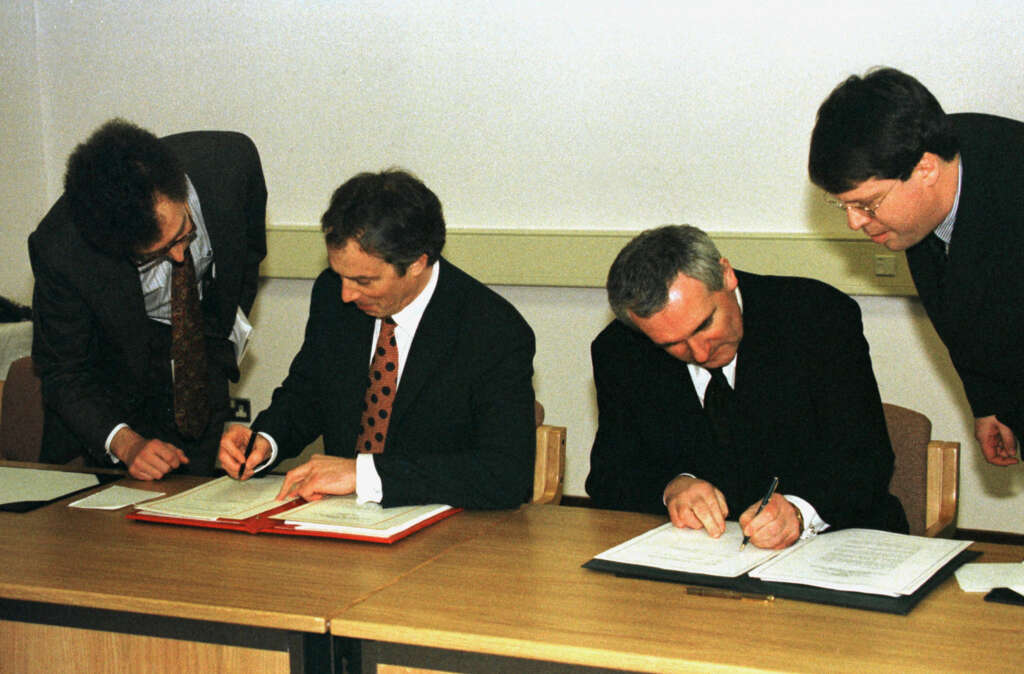
By Padraic Halpin and Amanda Ferguson
BELFAST (Reuters) – On April 7, 1998, the head of Northern Ireland’s largest unionist party drafted a letter to the British prime minister announcing that he was leaving talks and that the latest attempt to end three decades of bloodshed in Northern Ireland was over.
Three days later one of the most significant peace deals of the late 20th century had been signed.
The anecdote was recounted by former Irish Prime Minister Bertie Ahern, who only recently learnt that Nobel Peace Prize winner David Trimble had put in writing how close he was to walking away.
“I didn’t know he (Trimble) actually did that until the other day,” Ahern, Ireland’s prime minister from 1997 to 2008, told Reuters in an interview near his home in north Dublin.
“That’s how serious it was.”
Trimble’s near walk-out typified – in the words of former British Prime Minister Tony Blair – the “extraordinary rollercoaster” of the days and long nights leading up to April 10, when the historic agreement was struck between Irish nationalists seeking a united Ireland and pro-British unionists wanting to remain part of the United Kingdom.
As Northern Ireland prepares to mark 25 years of peace, Blair, Ahern and former Sinn Fein leader Gerry Adams recalled the tense mood in the cramped group of buildings at the seat of the local Northern Ireland government where the talks were held.
A deal looked possible one minute but in tatters the next.
“When we turned up in Belfast that April, the thing was in a state of collapse so I didn’t think we would get an agreement. Sometimes it would be on, sometimes it would be off,” Blair said in an interview in London.
Many unionists, drawn mostly from the Protestant majority, would not talk directly to representatives of Sinn Fein, the political ally of the Irish Republican Army (IRA), and instead used the two prime ministers, who joined the local politicians during the final days, as middlemen.
Adams, who had been banned from speaking on British airwaves until just four years earlier, his words instead dubbed by actors, said his best discussions with unionists “was always in the men’s room because that was the only time that they were on their own”.
Ahern said the turning point came a day after Trimble drafted his letter to Blair. The Irish leader shifted Dublin’s position sufficiently to get the key unionist leader back on side.
Trimble would go on to share the Nobel Peace Prize with nationalist leader John Hume, whose party was the main voice of minority Catholic voters at the time.
“It went from 6:30 in the morning hitting the wall to ending up that night… I won’t say done and dusted but certainly moved along,” Ahern said, referring to back-and-forth negotiations through Wednesday, April 8, during which he had also flown back to Dublin for his mother’s funeral before returning to Belfast.
“ALTERNATIVE WAS MAYHEM”
The compromise struck in the early hours of Friday acknowledged Northern Ireland’s constitutional status as part of the UK, but also that a united Ireland could come about if a majority voted for it. It introduced a powersharing executive, reformed the Protestant-dominated police force and led to the disarming of paramilitary groups.
The agreement, which ran to fewer than 40 pages, has largely ended three decades of violence that killed more than 3,600 people and made Northern Ireland unrecognisable economically and socially 25 years on, Blair, Ahern and Adams say.
“If you look at Northern Ireland today and you compare it with how it was, it’s a world of difference,” Blair said, pointing to a doubling in income per capita among the region’s 1.9 million people and in the number of tourists who visit each year.
Once conflict-ridden Belfast is now “a great and thriving city”, he said, noting that leaders such as Adams and Trimble had had to show huge courage and skill to bring their communities on side while critics were willing to “cry betrayal”.
“I was reading that half a million people have been born since the Good Friday Agreement was agreed,” Adams told Reuters in a building in Belfast’s nationalist Falls Road that was subjected to multiple attacks during the “Troubles”.
“So that’s half a million people – unless they have had personal or family experience of the conflict – that know nothing about it at a personal level. That a great boon.”
There have been shortcomings too.
More than 90% of schools in Northern Ireland remain segregated along religious lines, as is housing in many areas, entrenching some of the decade-old divisions, while politics has lurched from crisis to crisis.
“It (the agreement) is seen worldwide as being massively successful and one of the few peace processes that has worked. I find myself always looking at the bits that didn’t work,” Ahern said.
“(But) I think maybe people forget the dilemma that we were facing was that if we didn’t get the Good Friday Agreement done, the alternative was back to the mayhem… It’s made an enormous difference to the island.”
(Additional reporting by Kate Holton, writing by Padraic Halpin, Editing by Alex Richardson)


